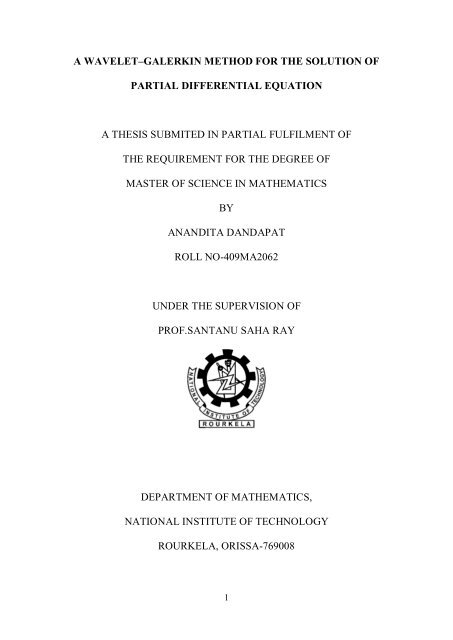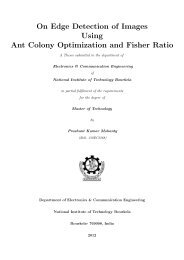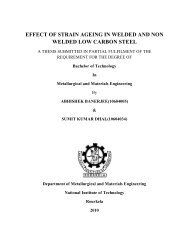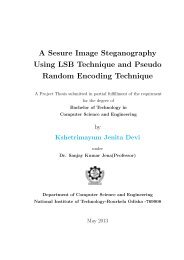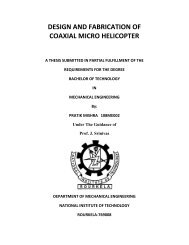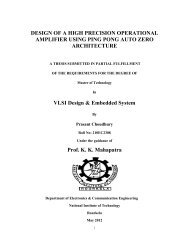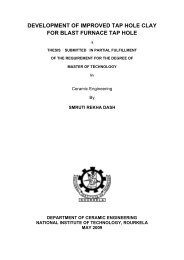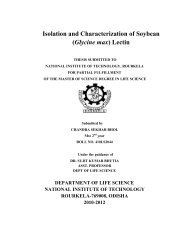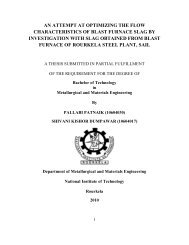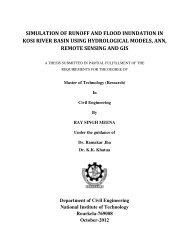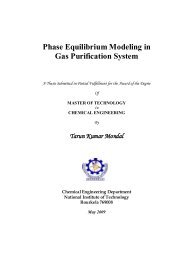j - ethesis - National Institute of Technology Rourkela
j - ethesis - National Institute of Technology Rourkela
j - ethesis - National Institute of Technology Rourkela
Create successful ePaper yourself
Turn your PDF publications into a flip-book with our unique Google optimized e-Paper software.
A WAVELET–GALERKIN METHOD FOR THE SOLUTION OF<br />
PARTIAL DIFFERENTIAL EQUATION<br />
A THESIS SUBMITED IN PARTIAL FULFILMENT OF<br />
THE REQUIREMENT FOR THE DEGREE OF<br />
MASTER OF SCIENCE IN MATHEMATICS<br />
BY<br />
ANANDITA DANDAPAT<br />
ROLL NO-409MA2062<br />
UNDER THE SUPERVISION OF<br />
PROF.SANTANU SAHA RAY<br />
DEPARTMENT OF MATHEMATICS,<br />
NATIONAL INSTITUTE OF TECHNOLOGY<br />
ROURKELA, ORISSA-769008<br />
1
NATIONAL INSTITUTE OF TECHNOLOGY<br />
ROURKELA<br />
CERTIFICATE<br />
This is to certify that the thesis entitled “Wavelet-Galerkin Method for the<br />
Solution <strong>of</strong> Partial Differential Equation” submitted by Ms. Anandita<br />
Dandapat, Roll No.409MA2062, for the award <strong>of</strong> the degree <strong>of</strong> Master <strong>of</strong><br />
Science from <strong>National</strong> <strong>Institute</strong> <strong>of</strong> <strong>Technology</strong>, <strong>Rourkela</strong>, is absolutely best<br />
upon her own work under the guidance <strong>of</strong> Pr<strong>of</strong>. (Dr.) S.Saha Ray. The results<br />
embodied in this thesis are new and neither this thesis nor any part <strong>of</strong> it has been<br />
submitted for any degree/diploma or any academic award anywhere before.<br />
Date: Dr.S.Saha Ray<br />
2<br />
Associate Pr<strong>of</strong>essor<br />
Department <strong>of</strong> Mathematics<br />
<strong>National</strong> <strong>Institute</strong> <strong>of</strong> <strong>Technology</strong><br />
<strong>Rourkela</strong>-769008, Orissa, India
DECLARATION<br />
I declare that the topic ‘A Wavelet-Galerkin method for the Solution <strong>of</strong><br />
Partial Differential Equation’ for my M.Sc. degree has not been submitted in<br />
any other institution or University for the award <strong>of</strong> any other degree or diploma.<br />
Place: Anandita Dandapat<br />
Date: Roll.No.409MA2062<br />
3<br />
Department <strong>of</strong> Mathematics<br />
<strong>National</strong> <strong>Institute</strong> <strong>of</strong> <strong>Technology</strong><br />
<strong>Rourkela</strong>-769008<br />
Orissa, India
ACKNOWLEDGEMENT<br />
I wish to express my deep sense <strong>of</strong> gratitude to my supervisor<br />
Dr. S. Saha Ray, Associate Pr<strong>of</strong>essor, Department <strong>of</strong> Mathematics, <strong>National</strong><br />
<strong>Institute</strong> <strong>of</strong> <strong>Technology</strong>, <strong>Rourkela</strong> for his inspiring guidance and assistance in<br />
the preparation <strong>of</strong> thesis.<br />
I am grateful to Pr<strong>of</strong>. P.C. Panda, Director, <strong>National</strong> <strong>Institute</strong> <strong>of</strong> <strong>Technology</strong>,<br />
<strong>Rourkela</strong> for providing excellent facilities in the institute for carrying out<br />
research.<br />
I also take the opportunity to acknowledge quite explicitly with gratitude my<br />
debt to the head <strong>of</strong> the Department pr<strong>of</strong>. G.K.Panda and all the pr<strong>of</strong>essors and<br />
staff, Department <strong>of</strong> Mathematics, <strong>National</strong> <strong>Institute</strong> <strong>of</strong> <strong>Technology</strong>, <strong>Rourkela</strong><br />
for his encouragement and valuable suggestions during the preparation <strong>of</strong> this<br />
thesis.<br />
I am extremely grateful to my parents and my friends, who are a constant source<br />
<strong>of</strong> inspiration for me.<br />
<strong>Rourkela</strong>, 769008 Anandita Dandapat<br />
May, 2011 Roll No-409MA2062<br />
4<br />
<strong>National</strong> <strong>Institute</strong> <strong>of</strong> <strong>Technology</strong><br />
<strong>Rourkela</strong>-769008<br />
Orissa, India
Abstract<br />
Wavelet function generates significant interest from both theoretical and<br />
applied research given in the last ten years. In the present project work, the<br />
Daubechies family <strong>of</strong> wavelets will be considered due to their useful properties.<br />
Since the contribution <strong>of</strong> compactly supported wavelet by Daubechies and multi<br />
resolution analysis based on Fast Fourier Transform (FWT) algorithm by<br />
Beylkin, wavelet based solution <strong>of</strong> ordinary and partial differential equations<br />
gained momentum in attractive way. Advantages <strong>of</strong> Wavelet-Galerkin Method<br />
over finite difference or element method have led to tremendous application in<br />
science and engineering.<br />
In the present project work the Daubechies families <strong>of</strong> wavelets have been<br />
applied to solve differential equations. Solution obtained may the Daubechies-6<br />
coefficients has been compared with exact solution. The good agreement <strong>of</strong><br />
mathematical results , with the exact solution proves the accuracy and efficiency<br />
<strong>of</strong> Wavelet-Galerkin Method.<br />
5
CONTENTS<br />
Chapter 1 Introduction 7<br />
Chapter 2 Wavelet based complete coordinate function. 9<br />
Chapter 3 Multiresolution. 13<br />
Chapter 4 Connection coefficient. 16<br />
Chapter 5 Singularity perturbed second-order boundary<br />
value problem. 19<br />
Chapter 6 Example 23<br />
Chapter 7 Conclusion 29<br />
Bibliography 31<br />
6
Introduction<br />
CHAPTER-1<br />
Wavelet Galerkin method is useful to solve partial differential equation.<br />
Wavelet analysis is a numerical concept which allows representing a function in<br />
terms <strong>of</strong> a set <strong>of</strong> basis functions, called wavelets, which are localized both in<br />
location and scale. Wavelets used in this method are mostly compact support<br />
introduce by Daubechies [1].<br />
The wavelet based approximations <strong>of</strong> ordinary and partial differential equations<br />
[1-4] have been attracting the attention, since the contribution <strong>of</strong> orthonormal<br />
bases <strong>of</strong> compactly supported wavelet by Daubechies [5] and Multiresolution<br />
analysis based Fast Wavelet Transform Algorithm (F.W.T) by Beylkin [6]<br />
gained momentum to make wavelet approximations attractive. Among the<br />
wavelet approximations, the Wavelet-Galerkin technique [7-10] is the most<br />
frequently used scheme nowadays .Wavelet based numerical solutions <strong>of</strong> partial<br />
differential equations have been developed by several researchers [2, 3, 7, 10-<br />
14].<br />
Daubechies constructed a family <strong>of</strong> orthonormal bases <strong>of</strong> compactly supported<br />
2 wavelets for the space <strong>of</strong> square-integrable function L ( R)<br />
. The Wavelet-<br />
Galerkin scheme involves the evaluation <strong>of</strong> connection coefficients are integrals<br />
with integrands being products <strong>of</strong> wavelet bases and their derivatives.<br />
7
Due to the derivatives <strong>of</strong> compactly supported wavelets, it is difficult and<br />
unstable to compute the connection coefficients by the numerical evaluation <strong>of</strong><br />
integral. The connection coefficients and the associated computations<br />
algorithms have been developed in [8,12] for bounded and unbounded domains.<br />
2 Wavelet (x)<br />
: An oscillatory function ( x) L ( R)<br />
with zero mean is a wavelet<br />
if it has the desirable properties:<br />
1.Smoothness: (x)<br />
is n times differentiable and that their derivatives are<br />
continuous.<br />
2.Localization: (x)<br />
is well localized both in time and frequency domains, i.e.,<br />
(x)<br />
and its derivatives must decay very rapidly. For frequency localization<br />
ˆ ( )<br />
must decay sufficiently fast as and that ˆ ( )<br />
becomes flat in the<br />
neighborhood <strong>of</strong> 0.<br />
The flatness is associated with number <strong>of</strong> vanishing<br />
moments <strong>of</strong> (x)<br />
, i.e.,<br />
<br />
<br />
<br />
x ( x)<br />
dk 0<br />
k or equivalently ˆ ( )<br />
0<br />
k<br />
k<br />
d<br />
for k 0,<br />
1 ,......, n<br />
d<br />
in the sense that larger the number <strong>of</strong> vanishing moments more is the flatness<br />
when is small.<br />
3.The admissibility condition<br />
<br />
<br />
<br />
suggests that<br />
ˆ<br />
(<br />
2<br />
) d<br />
<br />
<br />
2<br />
ˆ ( )<br />
decay at least as<br />
1<br />
or<br />
8<br />
1<br />
x for 0.
Chapter-2<br />
Wavelet Based Complete coordinate Function<br />
The Daubechies [5, 15] defined the class <strong>of</strong> compactly supported<br />
wavelets. This means that they have non zero values within a finite interval and<br />
have a zero value everywhere else. Let (x)<br />
be a solution <strong>of</strong> scaling relation<br />
L 1<br />
k 0<br />
(<br />
x ) a (<br />
2x<br />
k)<br />
(1)<br />
k<br />
The expression (x)<br />
is called Scaling function. And wavelet function (x)<br />
is<br />
( x<br />
1<br />
<br />
k <br />
L<br />
1k<br />
k<br />
) ( 1)<br />
a (<br />
2x<br />
k)<br />
(2)<br />
where L is positive even integral.<br />
From the normalization (x ) 1<br />
<strong>of</strong> the scaling function, the first condition can<br />
be written as follows,<br />
1<br />
<br />
0<br />
L<br />
k <br />
The translation <strong>of</strong> (x)<br />
are required to be orthonormal<br />
a 2<br />
(3)<br />
k<br />
9
(<br />
x k)<br />
(x<br />
- m) k,<br />
m<br />
(4)<br />
This formula (4) implies the second condition<br />
L 1<br />
k 0<br />
a (5)<br />
k ak<br />
2m<br />
0m<br />
Where is the Kronecker delta function.<br />
Smooth wavelet function requires the moment <strong>of</strong> the wavelet to be zero<br />
<br />
x ( x)<br />
dx 0<br />
m (6)<br />
This formula (6) implies the third condition<br />
L 1<br />
k 0<br />
( 1)<br />
k<br />
m<br />
k ak<br />
0 for m 0, 1 ,...., L 1<br />
(7)<br />
2<br />
Figure1: Daubechies’ scaling and wavelet function for L 6 .<br />
10
For the coefficients satisfying with the above condition, the function, which<br />
j consist <strong>of</strong> translation and dilations <strong>of</strong> the scaling function ( 2 x k)<br />
or the<br />
j wavelet function ( 2 x k)<br />
form a complete and orthogonal basis. The relation<br />
between two functions is expressed as:<br />
<br />
<br />
<br />
V V W<br />
j1<br />
j<br />
j<br />
(<br />
x ) (<br />
x m)<br />
dx 0,<br />
for any integer m (8)<br />
where denotes the orthogonal direct sum. Also, j V and W j be the<br />
2<br />
subspaces generated, respectively, as the L -closure <strong>of</strong> the linear spans <strong>of</strong><br />
j<br />
2 j<br />
2 j<br />
( x)<br />
2 (<br />
2 x k)<br />
and ( x)<br />
2 (<br />
2 x k)<br />
, k <br />
.<br />
jk<br />
The condition (8) implies that<br />
V<br />
0 V1<br />
..... V j V j1<br />
and V j<br />
V0<br />
W0<br />
W1<br />
......<br />
W<br />
j<br />
jk<br />
j<br />
1 (9)<br />
Here, j is the dilation parameter as the scale. For a certain value <strong>of</strong> j and L, the<br />
j support <strong>of</strong> the scaling function ( 2 x k)<br />
is given as follows.<br />
j k L k 1<br />
Supp(<br />
( 2 x k))<br />
, j j (10)<br />
2<br />
2 <br />
As the scaling function yield a complete coordinate function basis, it can be<br />
used to expand a general function as follows<br />
j j<br />
f ( x)<br />
2 ck<br />
(<br />
2 x k)<br />
(11)<br />
k<br />
11
For this expansion, we have the following convergence property,<br />
where<br />
f<br />
j<br />
jp ( p)<br />
k ck<br />
(<br />
2 x k)<br />
C2<br />
f<br />
(12)<br />
c<br />
k<br />
j<br />
f ( x)<br />
(<br />
2 x k)<br />
dx<br />
and C and p are constants.<br />
Here it is worth emphasizing that <strong>of</strong> a proper scale is very important. For<br />
example, to express a function having five periods in one interval, the scale j<br />
which at least has five translated components <strong>of</strong> the corresponding scaling<br />
function in the same interval must be selected. Besides this, there is another<br />
important point that scale j also affects the convergence in computational<br />
estimation. As we can see from the convergence property (12), the expanded<br />
function approaches the real value <strong>of</strong>, as j .<br />
12
2 Multiresolution in L ( R)<br />
CHAPTER 3<br />
Multiresolution analysis is the method <strong>of</strong> most <strong>of</strong> the practically relevant<br />
discrete wavelet transform.<br />
2<br />
A Multiresolution analysis <strong>of</strong> the space L ( R)<br />
consist <strong>of</strong> a<br />
sequence <strong>of</strong> closed subspace V j with the following properties:<br />
1) V j j 1<br />
V , j<br />
Z<br />
2) f ( x)<br />
<br />
Vj f ( 2x)<br />
Vj<br />
1<br />
3) f ( x)<br />
V f ( x 1)<br />
V<br />
jZ<br />
0<br />
j V<br />
2<br />
4 ) is dense in L ( R),<br />
V 0 j j Z<br />
0<br />
The existence <strong>of</strong> a scaling function (x)<br />
is required to generate a basis in each<br />
V j by<br />
With<br />
V<br />
j<br />
span<br />
jii<br />
Z<br />
j<br />
2 (<br />
2 x i),<br />
j,<br />
i Z<br />
2<br />
ij<br />
j<br />
In the classical case this basis orthonormal, so that<br />
13
, <strong>of</strong> which the translates and dilates constitutes orthonormal<br />
bases <strong>of</strong> the spaces j<br />
With f , g f ( x)<br />
g(<br />
x)<br />
dx,<br />
<br />
<br />
being the usual inner product.<br />
j1<br />
W . , , ji jk ik<br />
Let the j W denote a subspace complementing the subspace j<br />
V V<br />
W<br />
.<br />
j<br />
j<br />
14<br />
R<br />
V i.e.<br />
V in j1<br />
Each element <strong>of</strong> V j1<br />
can be uniquely written as the sum <strong>of</strong> an element inV j ,<br />
and an element in W j which contains the details required to pass from an<br />
approximation at level j to an approximation at level j 1.<br />
Based on the function (x)<br />
Wj span<br />
ji<br />
i Z<br />
Generated by the wavelets<br />
<br />
ji<br />
j<br />
one can find (x)<br />
j<br />
2 ( 2 x i),<br />
j,<br />
i Z<br />
2 2<br />
Each function f L ( R)<br />
, can now be expressed as<br />
Where<br />
ji<br />
<br />
iZ<br />
<br />
<br />
j<br />
j0<br />
<br />
f ( x)<br />
c ( x)<br />
d ( x)<br />
ji<br />
R<br />
ji<br />
j0i<br />
j0i<br />
c f , d f , <br />
ji<br />
R<br />
iZ<br />
, the so-called mother wavelet<br />
The scaling function (x) and its mother wavelet (x)<br />
have the following<br />
properties:<br />
ji<br />
ji
and<br />
<br />
<br />
( x)<br />
dx<br />
1,<br />
(<br />
<br />
x j)<br />
(<br />
x i)<br />
dx i,<br />
j<br />
x k <br />
( x)<br />
dx 0,<br />
k <br />
0,<br />
1,<br />
2<br />
( x) ( x k)<br />
dx 0 , For any integer k<br />
This condition implies that Vj1 VjWjon<br />
each fixed and scale j , the<br />
wavelets jk ( x)<br />
kZ jk ( x)<br />
kZ form an orthonormal basis W j and the scaling functions<br />
form an orthonormal basis <strong>of</strong> j V<br />
The set <strong>of</strong> spaces <strong>of</strong> set V j is called as Multiresolution analysis <strong>of</strong> ) (<br />
2<br />
L R .These<br />
spaces will be used to approximate the solutions <strong>of</strong> Partial Differential<br />
Equations using the Wavelet-Galerkin method.<br />
15
Connection coefficients<br />
CHAPTER 4<br />
In order to solve the differential equation by using wavelet Galerkin<br />
method there we need connection coefficients,<br />
<br />
<br />
<br />
d1d2<br />
d1<br />
d2<br />
( x)<br />
( x)<br />
dx<br />
l l<br />
1 2<br />
l<br />
1<br />
Taking the derivatives <strong>of</strong> the scaling function d times, we get<br />
N 1<br />
d<br />
k 0<br />
d<br />
d<br />
( x) 2 a ( 2x<br />
k)<br />
After simplification and considering it for all<br />
equations with<br />
where d d1<br />
d 2<br />
1 2 d d<br />
as unknown vector:<br />
d1d2<br />
d1<br />
2<br />
T d 1<br />
2<br />
1 d<br />
and i q<br />
l<br />
a a T 2<br />
i<br />
k<br />
The moments M i <strong>of</strong> i are defined as<br />
0 with 1 M<br />
<br />
k k<br />
M i x i<br />
<br />
0 <br />
( x)<br />
dx<br />
Latto et al derives a formula as<br />
M<br />
m<br />
i<br />
<br />
2(<br />
2<br />
1<br />
m<br />
1)<br />
m<br />
k<br />
mt<br />
i <br />
t0<br />
m<br />
<br />
t<br />
<br />
i<br />
l<br />
k<br />
t1<br />
l0<br />
2<br />
t<br />
<br />
<br />
l<br />
<br />
16<br />
L1<br />
i0<br />
a i<br />
d1d2<br />
l1l<br />
, gives a system <strong>of</strong> linear<br />
2<br />
tl<br />
i
where a i ’s are the Daubechies wavelet coefficients.<br />
Tables regarding the value <strong>of</strong> Scaling function and Connection coefficients at<br />
j=0 and L=6 have been provided by Latto et al [8].<br />
Table 1 scaling function (x)<br />
x (x)<br />
0 0<br />
0.5 0.60517847E+00<br />
1 0.12863351E+01<br />
1.5 0.44112248E+00<br />
2 -0.38583696E+00<br />
2.5 -0.14970591E-01<br />
3 0.95267546E-01<br />
3.5 -0.31541303E-01<br />
4 0.42343456E-02<br />
4.5 0.21094451E-02<br />
5 0<br />
17
Table 2 : Daubechies Wavelet filter coefficients, L=6<br />
a 0 0.470467207784<br />
a 1 1.14111691583<br />
a 2 0.650365000526<br />
a 3 -0.190934415568<br />
a 4 -0.120832208310<br />
a 5 0.0498174997316<br />
Table 3: Connection coefficient at L 6, j 0 [ n k]<br />
<br />
<br />
( x k)<br />
(<br />
x n)<br />
dx<br />
[4]<br />
0.00535714285714<br />
[3]<br />
0.11428571428571<br />
[2]<br />
-0.87619047619052<br />
[1]<br />
3.39047619047638<br />
[ 0]<br />
-5.26785714285743<br />
[ 1]<br />
3.39047619047638<br />
[ 2]<br />
-0.87619047619052<br />
[ 3]<br />
0.11428571428571<br />
[ 4]<br />
0.00535714285714<br />
18
CHAPTER 5<br />
Singularly perturbed second-order boundary value problem<br />
Wavelet-Galerkin scheme for the singularly perturbed boundary value<br />
problem<br />
u <br />
u<br />
u f ( x)<br />
, 0 x 1,<br />
(13)<br />
subject to boundary condition<br />
u ( 0)<br />
0,<br />
u(1)<br />
0,<br />
where (o<
The parameter L implies that the wavelet associated with the set <strong>of</strong> L<br />
Daubechies filter coefficients is used as the solution bases. Substituting the<br />
wavelet series approximation (x)<br />
u j in (14) for u (x)<br />
in (13),<br />
j<br />
2 1 2<br />
j<br />
j<br />
<br />
2 1<br />
2 1<br />
d<br />
d<br />
ck<br />
( x)<br />
c ( x)<br />
c ( x)<br />
f ( x)<br />
2 jk k jk k<br />
jk <br />
(15)<br />
dx<br />
dx<br />
k 2<br />
L<br />
k 2<br />
L<br />
20<br />
k 2<br />
L<br />
To determine the coefficient c k , we take inner product <strong>of</strong> both sides <strong>of</strong> (15)<br />
with jl ,<br />
<br />
j<br />
2 1<br />
k 2<br />
L<br />
1<br />
c <br />
k<br />
0<br />
<br />
1<br />
<br />
0<br />
( x)<br />
( x)<br />
dx <br />
jk<br />
f ( x)<br />
( x)<br />
dx,<br />
jl<br />
jll<br />
j<br />
2 1<br />
k 2<br />
L<br />
l 2 L,<br />
3 L,...,<br />
2<br />
m<br />
1<br />
c <br />
k<br />
0<br />
<br />
( x)<br />
( x)<br />
<br />
jk<br />
j<br />
jl<br />
1.<br />
j<br />
2 1<br />
ck<br />
<br />
k 2<br />
L<br />
1<br />
0<br />
( x)<br />
( x)<br />
dx<br />
jk<br />
jl<br />
(16)<br />
i<br />
We assume that l i x a x f ( ) is a polynomial <strong>of</strong> degree m in x . We write the<br />
0<br />
equation in (16) as<br />
Where<br />
j<br />
2 1<br />
<br />
k 2<br />
L<br />
c<br />
j<br />
kl<br />
c<br />
k<br />
j<br />
2 1<br />
J<br />
bkl<br />
k 2<br />
L<br />
2 1<br />
j<br />
kl<br />
k 2<br />
L<br />
cK<br />
a<br />
jJ<br />
c<br />
K<br />
d<br />
j<br />
ml<br />
,<br />
l <br />
1<br />
1<br />
j<br />
ckl jk jl<br />
kl jk jl<br />
0<br />
0<br />
2-<br />
j<br />
( x)<br />
( x)<br />
dx,<br />
b <br />
( x)<br />
( x)<br />
dx,<br />
1<br />
<br />
<br />
L,3-<br />
L,...,2<br />
j<br />
j<br />
akl <br />
jk ( x)<br />
jl ( x)<br />
dx , d ml f ( x)<br />
jl ( x)<br />
dx<br />
0<br />
1<br />
0<br />
j<br />
1<br />
(17)
To find<br />
d , we put the value <strong>of</strong> f (x)<br />
yielding<br />
j<br />
ml<br />
m 1<br />
j<br />
i<br />
d ml = ai x jl<br />
i0<br />
0<br />
2 j<br />
We know ( x)<br />
2 (<br />
2 x l)<br />
jl<br />
Put this in above equation then<br />
j<br />
ml<br />
m<br />
i 2<br />
d a x 2 (<br />
2<br />
i0<br />
1<br />
<br />
i<br />
0<br />
m j<br />
1<br />
j<br />
i <br />
i0<br />
0<br />
<br />
m<br />
j<br />
j<br />
( x)<br />
dx<br />
j<br />
x l)<br />
dx<br />
2 i 2 j<br />
a 2 x 2 ( 2 x l)<br />
dx<br />
ai j ij <br />
i0<br />
j<br />
2<br />
2<br />
2 2<br />
n<br />
m<br />
Let M ( x)<br />
y ( y k)<br />
dy<br />
2<br />
k<br />
i<br />
i j<br />
So y ( y l)<br />
dy M l ( 2 )<br />
<br />
0<br />
j<br />
x<br />
o<br />
2<br />
J<br />
0<br />
i<br />
y ( y l)<br />
dy<br />
21
m 2<br />
j 2 i j<br />
Hence d ml ai<br />
M l ( 2 )<br />
j ij<br />
i0<br />
2 2<br />
<br />
m<br />
<br />
i0<br />
2<br />
a<br />
i i<br />
M 1 l<br />
( i<br />
) j<br />
2<br />
j<br />
( 2<br />
j<br />
)<br />
Equation (17) can be further put into the matrix-vector form as<br />
where<br />
C [ c<br />
j<br />
kl<br />
A [ a<br />
and<br />
j<br />
kl<br />
]<br />
]<br />
A<br />
1<br />
A1 U <br />
D<br />
C B A , (18)<br />
2L<br />
k<br />
, l<br />
2 1<br />
,<br />
2Lk<br />
, l<br />
2 1,<br />
j<br />
j<br />
B [ b<br />
[ c2L<br />
, c3L<br />
, c j<br />
2 1<br />
,<br />
D [<br />
d<br />
U <br />
]<br />
T<br />
j<br />
kl<br />
j<br />
kl<br />
]<br />
]<br />
2L<br />
k<br />
, l 2<br />
1,<br />
2L<br />
l<br />
2 -1,<br />
j<br />
Now, we have a linear system <strong>of</strong> 2 L 2 equations <strong>of</strong><br />
j<br />
the 2 L 2 unknown coefficients. We can obtain the coefficient <strong>of</strong> the<br />
approximate solution by solving this linear system.<br />
22<br />
j<br />
The solution U gives the coefficients in the Wavelet-Galerkin<br />
approximation<br />
u j (x)<br />
<strong>of</strong> u<br />
(x)<br />
j
CHAPTER-6<br />
Wavelet-Galerkin Solution <strong>of</strong> Shear Wave Equation:<br />
Consider a plate <strong>of</strong> finite extent in the z & y direction & <strong>of</strong> thickness 1 in x<br />
direction. For horizontal polarized shear wave, the governing partial differential<br />
equation is<br />
where<br />
2<br />
1 u<br />
u 2 2<br />
(19)<br />
c t<br />
uxx yy<br />
u u(<br />
x,<br />
y,<br />
t)<br />
We consider the solution <strong>of</strong> the wave equation as<br />
.<br />
u(<br />
x,<br />
y,<br />
t)<br />
substitute (20) in (19) we get<br />
where<br />
2<br />
<br />
2<br />
2 <br />
i(<br />
yt )<br />
e<br />
(20)<br />
2<br />
d u(<br />
x)<br />
2<br />
u(<br />
x)<br />
0<br />
(21)<br />
2<br />
dx<br />
<br />
<br />
c<br />
2<br />
<br />
So exact solution is<br />
u(<br />
x,<br />
y,<br />
t)<br />
i(<br />
yt<br />
)<br />
( A1<br />
sin x<br />
A2<br />
cos x)<br />
e<br />
(22)<br />
Wavelet Galerkin method solution<br />
23
Here, we shall consider L 6& J 0<br />
Consider the solution <strong>of</strong> ordinary differential equation (21) is<br />
u(<br />
x)<br />
j<br />
2<br />
ck<br />
k L1<br />
<br />
1<br />
k<br />
k 5<br />
j<br />
2 j<br />
2 (<br />
2 x k)<br />
, x [<br />
0,<br />
1]<br />
c (<br />
x k)<br />
, x [<br />
0,<br />
1]<br />
(23)<br />
Where are constants, the unknown co-efficient<br />
Substitute (23) in (21) we get<br />
d<br />
dx<br />
1<br />
2<br />
<br />
1<br />
<br />
2 k<br />
k 5 k 5<br />
1<br />
2<br />
c ( x k)<br />
c<br />
k (<br />
x k)<br />
0<br />
2<br />
c k<br />
( x k)<br />
ck(<br />
x k)<br />
0<br />
k5<br />
k5<br />
2 Without any loss <strong>of</strong> generality, let 1<br />
we have<br />
L1<br />
2<br />
1<br />
k<br />
2<br />
<br />
1<br />
k5<br />
1L<br />
k5<br />
1<br />
and taking inner product with ( x n)<br />
,<br />
2<br />
c <br />
(<br />
x k)<br />
(<br />
x n)<br />
c (<br />
x k)<br />
(<br />
x n)<br />
0<br />
2<br />
j<br />
j<br />
j<br />
24<br />
L1<br />
2<br />
k <br />
2<br />
1L<br />
2<br />
j<br />
j<br />
j
1<br />
1<br />
ck[<br />
n k]<br />
ck<br />
n,<br />
k 0<br />
(24)<br />
k5<br />
n 1 L,<br />
2 L,<br />
,<br />
2<br />
i.e; n 5,<br />
4,<br />
,<br />
0,<br />
1<br />
j<br />
k5<br />
where n k<br />
( x k)<br />
(<br />
x n)<br />
dx<br />
<br />
(<br />
x k)<br />
(<br />
x n)<br />
dx<br />
k, n <br />
By using Dirichlet boundary conditions<br />
u ( 0)<br />
1, u(<br />
1)<br />
0<br />
yielding this equation<br />
1<br />
u( 0)<br />
c (<br />
k)<br />
1<br />
and<br />
<br />
k 5<br />
1<br />
u( 1)<br />
c (<br />
1<br />
k)<br />
0<br />
<br />
k 5<br />
k<br />
k<br />
25<br />
(25)<br />
(26)<br />
From left boundary conditions, we get equation (25) and from right boundary<br />
conditions, we get equation (26), which represents the relation <strong>of</strong> the<br />
coefficients .
26<br />
Now we eliminate first and last equations <strong>of</strong> (24) and in that places are<br />
including equation (25) and (26) respectively, we get the following matrix<br />
with 6<br />
<br />
L .<br />
B<br />
TC <br />
<br />
<br />
<br />
<br />
<br />
<br />
<br />
<br />
<br />
<br />
<br />
<br />
<br />
<br />
<br />
<br />
<br />
<br />
<br />
<br />
<br />
<br />
<br />
<br />
<br />
<br />
<br />
<br />
<br />
<br />
<br />
<br />
<br />
<br />
<br />
<br />
<br />
<br />
<br />
<br />
<br />
<br />
<br />
<br />
<br />
<br />
<br />
<br />
<br />
<br />
<br />
<br />
<br />
<br />
<br />
<br />
<br />
<br />
<br />
<br />
<br />
<br />
<br />
<br />
<br />
<br />
<br />
<br />
<br />
<br />
<br />
<br />
<br />
<br />
<br />
<br />
<br />
<br />
0<br />
)<br />
1<br />
(<br />
)<br />
2<br />
(<br />
)<br />
3<br />
(<br />
)<br />
4<br />
(<br />
0<br />
0<br />
]<br />
1<br />
[<br />
1<br />
]<br />
0<br />
[<br />
]<br />
1<br />
[<br />
]<br />
2<br />
[<br />
]<br />
3<br />
[<br />
]<br />
4<br />
[<br />
]<br />
5<br />
[<br />
]<br />
2<br />
[<br />
]<br />
1<br />
[<br />
1<br />
]<br />
0<br />
[<br />
]<br />
1<br />
[<br />
]<br />
2<br />
[<br />
]<br />
3<br />
[<br />
]<br />
4<br />
[<br />
]<br />
3<br />
[<br />
]<br />
2<br />
[<br />
]<br />
1<br />
[<br />
1<br />
]<br />
0<br />
[<br />
]<br />
1<br />
[<br />
]<br />
2<br />
[<br />
]<br />
3<br />
[<br />
]<br />
4<br />
[<br />
]<br />
3<br />
[<br />
]<br />
2<br />
[<br />
]<br />
1<br />
[<br />
1<br />
]<br />
0<br />
[<br />
]<br />
1<br />
[<br />
]<br />
2<br />
[<br />
]<br />
5<br />
[<br />
]<br />
4<br />
[<br />
]<br />
3<br />
[<br />
]<br />
2<br />
[<br />
]<br />
1<br />
[<br />
1<br />
]<br />
0<br />
[<br />
]<br />
1<br />
[<br />
0<br />
0<br />
)<br />
1<br />
(<br />
)<br />
2<br />
(<br />
)<br />
3<br />
(<br />
)<br />
4<br />
(<br />
0<br />
<br />
<br />
<br />
<br />
<br />
<br />
<br />
<br />
T<br />
<br />
<br />
<br />
<br />
<br />
<br />
<br />
<br />
<br />
<br />
<br />
<br />
<br />
<br />
<br />
<br />
<br />
<br />
<br />
<br />
<br />
<br />
<br />
<br />
<br />
<br />
<br />
<br />
1<br />
0<br />
1<br />
2<br />
3<br />
4<br />
5<br />
c<br />
c<br />
c<br />
c<br />
c<br />
c<br />
c<br />
C and<br />
<br />
<br />
<br />
<br />
<br />
<br />
<br />
<br />
<br />
<br />
<br />
<br />
<br />
<br />
<br />
<br />
<br />
<br />
<br />
<br />
<br />
<br />
<br />
0<br />
0<br />
0<br />
0<br />
0<br />
0<br />
1<br />
B<br />
By Gaussian elimination algorithm we get<br />
997181<br />
.<br />
0<br />
5<br />
<br />
<br />
<br />
c<br />
877618<br />
.<br />
0<br />
3<br />
<br />
<br />
<br />
c<br />
127868<br />
.<br />
0<br />
2 <br />
<br />
c
c 1<br />
1.<br />
08705<br />
0 0.<br />
24756 c<br />
c<br />
1<br />
<br />
0.<br />
505899<br />
The Exact solution by using Dirichlet boundary condition is<br />
u( x)<br />
cos x cot<br />
1sin<br />
x<br />
Table-4 shows the comparison between Wavelet-Galerkin solution and Exact<br />
solution<br />
Table 4 Comparison between wavelet Solution and Exact Solution<br />
x Wavelet solution Exact solution Absolute Error<br />
0 1 1 0<br />
0.125 0.921657 0.912145 0.00951209<br />
0.25 0.829106 0.810056 .0190502<br />
0.375 0.726413 0.69535 0.031086<br />
0.5 0.609339 0.569747 0.0395922<br />
0.625 0.477075 0.435276 0.041798<br />
0.75 0.331501 0.294014 0.0374878<br />
0.875 0.172689 0.148163 0.0245264<br />
1 0 0 0<br />
The value <strong>of</strong> above table & using MATLAB we obtain the following graph<br />
27
Figure 2: Comparison between wavelet Solution and Exact Solution<br />
.To exhibit a comparison between Wavelet-Galerkin solution and Exact<br />
solution, figure2 has been diagrammed by MATLAB. A good agreement <strong>of</strong><br />
result has been obtained as doted by figure 2.<br />
28
CONCLUSION<br />
CHAPTER-7<br />
Wavelet-Galerkin method is the most frequenly used scheme now a days.<br />
In the present project work, the Daubechies family <strong>of</strong> the wavelet have been<br />
consider. Due to the fact that they posses several useful properties, such as<br />
orthogonality, compact support, exact representation <strong>of</strong> polynomials to a certain<br />
degree and ability to represent function at different levels resolution.<br />
Dabauchies’ wavelets have gained great interest in the numerical solution <strong>of</strong><br />
ordinary and partial differential equation.<br />
An obtain advantages <strong>of</strong> this method <strong>of</strong> this method is that it uses Daubechies’<br />
coefficients and calculate the Scaling function, the connection coefficients as<br />
well as the rest <strong>of</strong> component only once.<br />
This leads to a considerable saving <strong>of</strong> the computational time and improves<br />
numerical results through the reduction <strong>of</strong> round-<strong>of</strong>f errors.<br />
The Wavelet-Galerkin method has been shown to be a powerful numerical tool<br />
for fast and more accurate solution <strong>of</strong> differential equations, it can be observed<br />
from the result. Wavelet Galerkin method yields better result, which shows the<br />
effiency <strong>of</strong> the method.<br />
29
Solution obtained using the Daubechies 6 coefficients wavelet has been<br />
compared with the exact solution. The good agreement <strong>of</strong> its numerical result<br />
with the exact solution proves its accuracy and efficiency .<br />
30
BIBLIOGRAPHY<br />
[1] Daubechis,I, 1992 , Ten Lectures on Wavelet, Capital City Press, Vermont.<br />
[2] qian,s. and Weiss,J.,1993 Wavelet and the numerical solution <strong>of</strong> boundary<br />
value problem, Appl. Math. Lett, 6, 47-52<br />
[3] qian,s., and Weiss,J.,1993 Wavelet and the numerical solution <strong>of</strong> partial<br />
differential equation ‘, J. Comput. Phys, 106, 155-175<br />
[4] Williams,J.R.and Amaratunga,K., 1992, Intriduction to Wavelet in<br />
engineering, IESL Tech.Rep.No.92-07,Intelegent Engineering system<br />
labrotary,MIT.<br />
[5] Daubechies,I.,1988, Orthonormal bases <strong>of</strong> compactly supported wavelets,<br />
Commun. Pure Appl. Math., 41, 909-996.<br />
[6] Beylkin,G., coifman,R. and Rokhlin,V., 1991,Fast Wavelet Transfermation<br />
and Numerical Algorithm, Comm. Pure Applied Math.,44,141-183<br />
[7] K. Amaratunga, J.R. William, s. qian and J. Weiss, wavelet-Galerkin<br />
solution for one dimentional partial differential equations, Int. J. numerical<br />
methods eng. 37, 2703-2716 (1994).<br />
[8] Latto,A., Resnik<strong>of</strong>f, H.L and Tenenbaum,E., 1992 The Evaluation <strong>of</strong><br />
connection coefficients <strong>of</strong> compactly Supported Wavelet: in proceedings <strong>of</strong> the<br />
French-USA Workshop on Wavelet and Turbulence, Princeton, New York, June<br />
1991,Springer- Verlag,.<br />
31
[9] Williams,J.R.and Amaratunga,K.,1994, High order Wavelet extrapolation<br />
schemes for initial problem and boundary value problem,IESL Tech.Rep.No.94-<br />
07,Inteligent Engineering systems Labrotary,MIT.<br />
[10] J.c., and W.-c., Galerkin-Wavelet method for two point boundary value<br />
problems, Number. Math.63 (1992) 123-144.<br />
[11] Comparison <strong>of</strong> boundary by Adomain decomposition and Wavelet-<br />
Galerkin methods <strong>of</strong> boundary-value problem,181(2007)652-664<br />
[12]The computation <strong>of</strong> Wavelet-Galerkin method on a bounded interval,<br />
International Journal for Numerical Methods in Engineering,Vol.39,2921-2944<br />
[13] Treatment <strong>of</strong> Boundary Conditions in the Application <strong>of</strong> Wavelet-Galerkin<br />
Method to a SH Wave Problem. Dianfeng LU, Tadashi OHYOSHI,Lin ZHU.<br />
[14] Wavelet-Galerkin solution <strong>of</strong> ordinary differential equations, Vinod Mishra<br />
and Sabina, Int. Journal <strong>of</strong> Math. Analysis, Vol.5, 2011, no.407-424<br />
[15] S.Mallat, Multiresolution approximation and wavelets, Trans. Amer. Math.<br />
Soc., 315,69-88(1989).<br />
32


